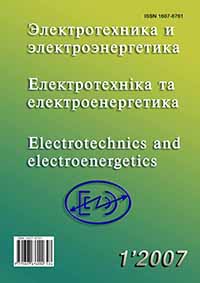SLIDING REGIME FOR VALOGENERATOR FREQUENCY CONTROL
Keywords:
Regulator, mode, control, current, frequencyAbstract
The parallel work of shaft-generator with generators of ship power station using the sliding mode regulatorthat functions together with a fuzzy-regulator, the problem of reduction of rotation frequency fluctuations and
of shaft-generator loading corner is solved.
References
Теоретические основы эксплуатации судовых дизелей // В. Ю. Гиттис, В. Л. Бондаренко, Т. П. Ефимов и др. – М.: Транспорт, 1965. – 376 с.
Колодяжный В. В., Дворак В. Н. Стабилизация динамических и статических характеристик контура регулирования напряжения судового синхронного генератора // Електомашинобудування та електрообладнання. – 2006. – Вип. 66. – С. 391–393.
Шостак В. П., Гершаник В. И. и др. Проектирование пропульсивной установки судов с прямой передачей мощности на винт: Учебное пособие. –
Николаев: УГМТУ, 2003. – 500 с.
Богомолов В. С. Судовые электроэнергетические установки подчиненного управления. /Ред. С. А. - Горбунова; Калининград: Кн. изд-во. 1996. – 240 с.
Дворак В. Н. Стабилизация динамических характеристик автоматизированного дизель-генераторного агрегата // Матеріали міжнародної науково-технічної конференції «Електротехніка і електромеханіка ETEM-2005». – Миколаїв, 2005. – С. 16–21.
Болотин Б. И., Вайнер В. Л. Инженерные методы расчетов устойчивости судовых автоматизированных систем. – Л.: Судостроение, 1974. – 332 с.
Дворак В. Н. К расчету реакции САУ скользящего режима дизель-генераторного агрегата на внезапное изменение нагрузки и возбуждения // Рыбное хозяйство Украины.– 2006. –№7. – С. 7–8.
Downloads
How to Cite
Issue
Section
License
Copyright (c) 2017 V. M. Dvorak, D. I. Osovski

This work is licensed under a Creative Commons Attribution 4.0 International License.
Creative Commons Licensing Notifications in the Copyright Notices
Authors who publish with this journal agree to the following terms:
Authors retain copyright and grant the journal right of first publication with the work simultaneously licensed under aCreative Commons Attribution License that allows others to share the work with an acknowledgement of the work's authorship and initial publication in this journal.
Authors are able to enter into separate, additional contractual arrangements for the non-exclusive distribution of the journal's published version of the work (e.g., post it to an institutional repository or publish it in a book), with an acknowledgement of its initial publication in this journal.
Authors are permitted and encouraged to post their work online (e.g., in institutional repositories or on their website) prior to and during the submission process, as it can lead to productive exchanges, as well as earlier and greater citation of published work.

